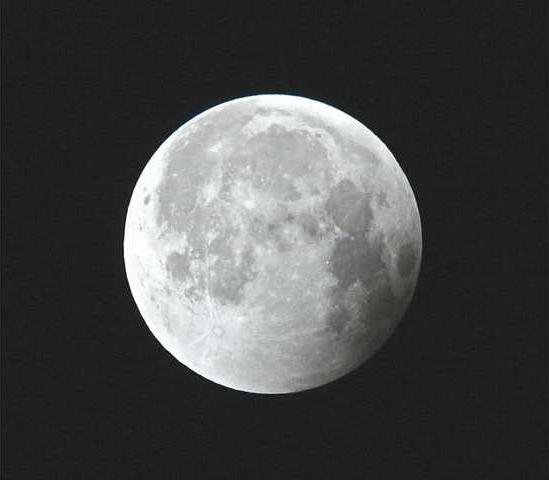I hurried outside into the parking lot of the Manteca Bulletin as I took a quick break from work. The time was 1:37 a.m., Tuesday, Dec. 21, 2010.
The lunar eclipse was already under way.
Caught without a tripod, I found a way to compensate for the lack of a steady contraption upon which to set my camera and reduce image blurriness. I braced myself against my vehicle, held my breath then started shooting. As I was firing the last few shots before going back inside the office, the cell phone in my pocket rang.
“Are you down on your knees giving your thanks to God?” I heard my husband’s voice say.
My attention still fixed on the unfolding vision in the sky, with half of my attention on my camera settings, I was not able to digest what he was telling me at first. Hearing the puzzled tone in my voice, he then reminded me of our conversation after dinner earlier that evening.
I told him I was not going to miss taking pictures of the lunar eclipse that night – actually, the wee hours of the morning. He smiled indulgently as he tried hard not to curb my enthusiasm and my overt excitement. He kindly reminded me how bad the weather had been the last few days, how inclement it still is, and how the sky is still heavy with dark clouds that evening. My solo photo safari could end up being a dud, he warned. He didn’t want me to get disappointed.
But I was determined to take pictures of this celestial phenomenon, and I told him so. “The sky will be clear,” I said in total confidence.
And sure enough, thanks to nothing short of a divine intervention as far as I’m concerned, when I checked the night sky shortly before midnight, there was the moon overhead in its full shining glory against a clear sky surrounded by a smattering of stars, at least, those that were not obliterated by the light pollution from the Earth.
This was not just one of those full lunar eclipses that occur about once a year, I reminded my husband, explaining to him why this was one photo safari I was determined not to miss even if it meant staying up at 2 a.m. This is a once-in-a-lifetime phenomenon, I said.
Of course, he already knew. Practically the whole world knew about it since it’s been splashed all over the Internet that this is the first time since Dec. 21, 1638 that a full lunar eclipse is occurring on the day of the winter solstice, the first day of winter, and the shortest day of the year.
Many photographers and videographers from all over the world captured the celestial phenomenon in many dramatic ways. Go on the Internet and you’ll find no shortage of the many breathtaking photographs taken in practically every continent. I was quite envious with the photographers who had the luxury of time and space and scenic settings to juxtapose the eerie orange moon hanging like a magnificent out-of-this-world gem in the sky. Those that showed the ruddy moon, its full round surface covered by the shadow of the Earth as it moved past the sun, juxtaposed against buildings, trees, snow scenes, an urban horizon, and street lights were the most dramatic, in my opinion. A favorite among the photographs I’ve viewed so far showed a trio of skiers in Switzerland silhouetted against a giant, almost full moon.
Unfortunately, I missed the moment when the moon was completely shaded by the Earth. But I was able to capture the tail end of the Earth’s march across the lunar face.
It was a magical moment. But that was not the only magical thing that transpired during this historic night. As I stood in the parking lot next to my vehicle, taking pictures of the moon that has recaptured its full shining glory, a bank of gossamer-like clouds from the southeast started rushing toward it. As the translucent clouds glided past the moon, a corona of rainbow colors encircled it. Quickly changing my camera settings, I took a few more shots of this dramatic lunar scene.
According to the Associated Press which quoted a spokesman with the U.S. Naval Observatory, this full lunar eclipse on the first day of the winter solstice won’t happen again until Dec. 21, 2094 which makes Tuesday morning’s celestial vision truly a once-in-a-lifetime experience.





